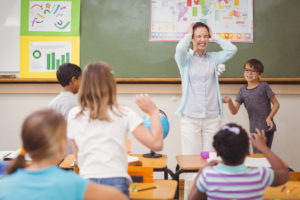What is TPRS And How to Use It Effectively
Who doesn’t love a good story? We’ve been telling them since before the written word. They’re an easy way to share our experiences and connect with one another. And as it turns out, they’re a fantastic method to learn a new language. If you’re interested in reaching fluency in a foreign language, then you need to take a look at Teaching Proficiency through Reading and Storytelling (TPRS) and why it’s so effective.
Understanding Comprehensible Input, TPR, and TPRS
In the 1990s, Blaine Ray created TPRS while teaching Spanish. He was familiar with the works of Stephen Krashen and Dr. James Asher and developed his method after implementing both of their ideas into his classroom lessons.
Stephen Krashen’s Input Hypothesis focuses on the importance of comprehensible input in language acquisition. Essentially, he argues that we can either learn or acquire a language. Learning is basically classroom instruction, heavily focused on the structure of language and grammar, for instance, with drilling and testing at the core. Acquiring, on the other hand, comes from a natural interaction with language, such as spontaneous communication.

Krashen also argues that the input needs to be comprehensible, or easily enough to be understood on its own. If it’s too hard, people give up, and if it’s too easy, people tend to tune out. It’s a kind of Goldilocks Zone for language learning. (Teachers often use a version of this in general instruction called, the Zone of Proximal Learning). In short, lessons should be approachable and learning targets should be within reach.
Dr. Asher developed Total Physical Response (TPR) after 30 years of laboratory research. Essentially, it pairs physical movement with language education. It’s meant to reflect how infants learn languages in a stress-free environment. The process uses actions and language to support second language acquisition.
Blaine Ray combined TPR, the input hypothesis, and his own efforts as a Spanish instructor to create TPRS. As a result, TPRS uses approachable stories that are within the “Goldilocks Zone” of comprehension along with fun, exciting, and active lessons designed to engage students. The lessons are also silly and overly dramatized to help reduce stress around language acquisition.
The results of TPRS speak for themselves. Students feel less apprehensive about language-learning and encouraged to engage with the content. Through spaced repetition, context, and interesting stories, TPRS helps support language-learning efforts.
What Are the Steps of TPRS?
TPRS focuses heavily on input-based activities by modeling Krashen’s input hypothesis and TPR’s active lessons. TPRS begins with choosing words in the target language for the lesson and defining their meaning before telling a story that uses them. Finally, the lesson finishes up with reading that reinforces the words covered in the lesson.

Here’s what each step of TPRS looks like in detail:
Step 1: Define Target Words/Phrases
The teacher defines a maximum of 3 words/phrases for the lesson. This allows them to repeat the words enough times during the lessons for students to remember the new content. The teacher then writes the words down on the board and usually defines the word using another color, making them easily accessible.
During this stage, the teacher will also practice the pronunciation with the students, giving them plenty of practice with the new words and phrases. Finally, depending on the approach, the teacher may also have students use gestures to help remember the language.

It’s often most helpful for the students to come up with the gestures themselves. The more personal they are, the easier they are to remember.
After the students are familiar with the words and phrases, the teacher will use the words to ask the students questions. Known as Personalized Questions and Answers (PQA), these questions are comprehensible to the students and serve as a foundation for the next step. The questions are simple, engaging, and often focus on the lives of the students, making them relevant.
On the surface, this seems like a highly-repetitive process. But it gets students familiar with the target vocabulary so that they can better interact with the next part of the lesson.
Step 2: Tell a Story
Next, the teacher will tell a very basic story using both the new words and the answers to the student’s questions. These stories are light-hearted, entertaining, and funny. They’re not meant to test the language-learners, but rather, give them an opportunity to hear the new words and see them used properly. The students also get to practice them in a stress-free environment.
The story allows the teacher to gauge their student’s progress toward acquiring these new words. Using simple questions around the context of the story, a teacher may only say one sentence but ask several repetitive, but slightly different questions. If the teacher feels the class is struggling, they may pause and reinforce the lesson. However, if they can tell that the class gets it, then they can move on.

One key element about these stories is that they’re not concrete: the students create the plot. How the students answer the questions determines the outcome. This helps set the lesson apart from being something that’s spoken at the students, turning it into something that’s created with them.
Inevitably, this approach draws more students into the events. And it gives them ownership while stimulating their curiosity. After all, no one knows how it’s going to end.
Step 3: Assign Reading Comprehension
The benefits of reading comprehension are enormous. That’s why the final step in TPRS involves reading. This allows students to further interact with their new phrases to help solidify the language-learning lesson. It also helps them see how the language functions in written form.
There are 4 types of reading:
- Class Reading: The teacher reads a story with the class that uses the words from the lesson, though it may differ in the plot. (The most common type of reading).
- Free Voluntary Reading: Students read any book in the target language.
- Homework Reading: This advanced strategy has students read at home to prepare for the next lesson or reflect on a current lesson. It can create problems, however, if learners struggle with the language.
- Shared Reading: Teachers read a low-level book in the target language that’s heavy in pictures. The teacher will ask questions based on target words/phrases.
What Does TPRS in Action Look Like?
With TPRS, the teacher will start the class by writing the new words or phrases on the board. These will be high-frequency, high-value words for students. Then, they’ll practice they’ll pronunciation with the students. Quickly, they’ll shift to asking questions about the word.

Here’s an example of TPRS:
Teacher: Steve rode his bike.
Students: Ooooh!
Because TPRS is designed to create a stress-free environment, teachers instruct students to provide exaggerated responses to statements. This can be phrases like “ooooh” or “ahhhh”.
Teacher: What did Steve ride?
Students: A bike!
Teacher: Yes! Steve rode a bike. Did Steve sell a bike?
Students: No!
Teacher: Yes! That’s right. Steve didn’t sell a bike. Steve rode a bike. Did Steve Ride a fish?
Students: No!
Teacher: Did Steve ride a horse?
Students: No!
Teacher: Did Steve ride a bike?
Students: Yes!
The teacher will continue this back and forth with the students using exaggeration and questions that may seem nonsensical at first. However, they allow the teacher to gauge comprehension. They also make the material approachable. Students can listen and answer without worrying about their internal monitor attempting to perfect what they’re trying to say.
Krashen highlights the role of the internal monitor in his input hypothesis. Essentially, this is the filter all of us have. It keeps us from making mistakes. When we’re younger, it’s less pronounced. This allows us to learn effortlessly because we’re not worried about looking stupid when we mess up. But as we grow older, our internal monitor can shut down language learning efforts completely.
By using laughable, easy-going material with simple answers, students don’t have to worry about looking silly. The whole lesson is silly. They won’t feel out of place, and there’s not a lot of pressure on them to perform. As a result, the teacher creates the perfect environment to stimulate language-learning.
Once the teacher finishes the question stage, they will either assign reading or complete a classroom reading activity that further enforces the new language.
The Types of TPRS Techniques
TPRS uses several specific techniques to support language acquisition. Some are used more than others, depending on the level of the students and how well they understand the lesson. Their purpose is to help students maintain comprehension in the target language throughout the lesson.

- Circling: Asking simple questions about the target words or phrases in the target language. These can be “Yes/No, Either/Or, Who, What, Where, When, or How Many” types of questions. They are easy in nature and promote simple answers that allow teachers to gauge progress while exposing students to language structures without grammar and syntax lessons.
- Inbounds: Only using words that have been covered or that the student understands. Keeping in line with Krashen, the lesson needs to be comprehensible or understood by the students. If it’s not, then that content needs to be thoroughly explained. Every time a teacher uses a word that’s “out-of-bounds” they need to define it. Other inbound words include cognates and proper nouns.
- Pop-Up Grammar: While lessons shouldn’t focus on grammar, teachers can provide quick lessons to help reinforce concepts. These lessons should be under 30 seconds and not the primary focus of the lesson.
- Eye Contact: By focusing on the students’ eyes during instruction, the teacher can better gauge whether or not students are progressing. Confusion and frustration can be easily assessed through eye-contact, and the teacher can decide whether or not they need to continue circling, re-explain, or move on.
- Student Focused: Lessons center around the students. They help create the stories, making them more interesting, meaningful, and memorable. Teachers ask the students questions about their lives and use the input for the stories.
Why Is TPRS Effective?
TPRS is very different from the failed language-learning methods of the past. It doesn’t rely heavily on memorization or drilling. It’s not about forcing students to speak rapidly or testing them on language as if it were an academic subject. Instead, TPRS uses methods backed by science to create an interactive learning environment for language learners.
People remember stories. It creates a context for them to apply their language-learning so that it doesn’t occur in a vacuum. They can think back to lessons, not as pages in a book, but as memories created in a fun and safe learning environment. This stress-free approach to language-learning makes it accessible.

But TPRS also focuses on two very important language learning methodologies: Spaced repetition and high-frequency words/phrases. Language learners don’t focus on grammar with TPRS; they don’t focus on syntax or rules; they don’t focus on abstract concepts. Instead, they get words and phrases they can use right away. During each lesson, they may hear the same word or phrase 100 or 200 times. With all the repetition, they get enough exposure at an increasing duration that helps them form lasting memories.
Criticism and Disadvantages of TPRS
TPRS is not a panacea for learning any language. Like many language-learning strategies out there, it has both pros and cons. For fast learners, the repetition can get old fast. And if you’re not one for “fun, interactive classroom lessons”, the idea of making gestures or silly stories can be annoying. And if that distracts you, chances are that you won’t be dialed into the lesson.
Comprehensible input also needs to be interesting. And with a lesson aimed for 30 people, chances are that some won’t find it all that intriguing. For those who simply aren’t interested, their learning takes the backseat while everyone else trudges onward.
TPRS can be problematic as well if you’re a shy learner. Any time you learn in a classroom setting, it can be hard to contribute. Shy students are more likely to mimic or mumble rather than speak coherently. And teachers can’t provide the 1:1 instruction needed to better guide the student to fluency.

The TPRS lessons can also be exhausting. Teachers have to be prepared to come in and provide a full-energy, hands-on language lesson for each class, all day, every day. Even the best teachers would find that demand difficult over time.
TPRS can lead to ineffective lessons as well. Without clear goals and progress towards those goals, learners can experience wasted efforts and lessons that don’t quite hit the mark. To succeed in your language learning, you need clear goals and a strategy to act on those goals. Without it, you can float in limbo, learning some words, but not enough to speak fluently.
TPRS Is One of Many Language Learning Strategies
Ultimately, there’s no one true way to learn a language. At OptiLingo, we feel that you should take advantage of the best strategies out there and use them to reach your language learning goals. Part of that is understanding which ones work right for you. Knowing what TPRS is and its downsides can help you decide if it’s right for you.
As a language-learner, you’re living at the best time to learn a new language. There are endless resources out there to help you reach your goal of achieving fluency in a foreign language. But it’s not always easy finding the right one. Worse, you may waste your time and money on one that’s stuck in the past, focusing on dated methods like drilling and memorization.
You need a foreign language learning program that works. OptiLingo differs from other programs because it prioritizes SPEAKING instead of memorizing grammar and vocabulary. And it’s built off the way people naturally learn languages. The result is an easy to use system that helps you gain fluency fast. See for yourself. Discover how OptiLingo works today!







